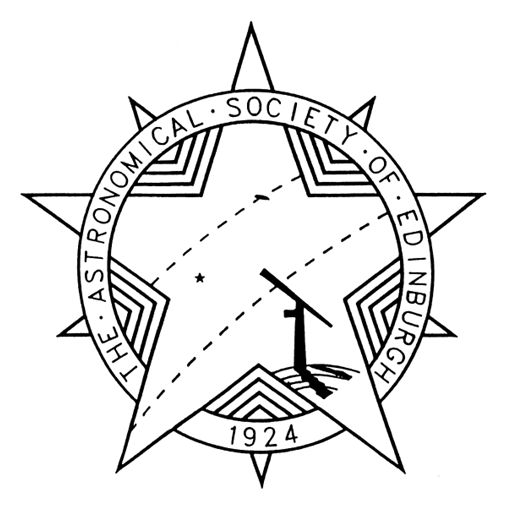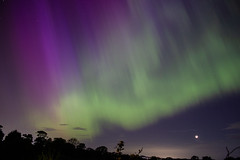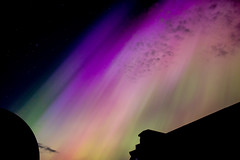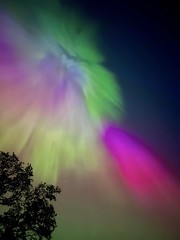Monthly Archives: June 2019
Scotland’s Sky in July, 2019
A partial eclipse of the Moon next to Saturn on the 16th

The maps show the sky at 01:00 BST on the 1st, midnight on the 16th and 23:00 on the 31st. (Click on map to enlarge)
July brings a slow return to darker and longer nights as the Sun’s trek southwards continues in the wake of our summer solstice. Until the 12th, the Sun dips no more than 12° below Edinburgh’s northern horizon so that twilight persists through every night. By the month’s end, though, we enjoy almost four hours of effective darkness and, with the Moon out of the way, the fainter stars are once again on show.
The 50th anniversary of Apollo 11’s pioneering lunar landing occurs on the 20th while, for stargazers and the weather permitting, the highlight may be the partial eclipse of the Moon which comes four days earlier on the evening of the 16th, though the Moon rises, and the Sun sets, while the eclipse is already underway.
The event begins at 19:44 BST when the Moon begins to encroach of the edge of the outer shadow of the Earth, the penumbra. Between 21:02 and midnight, part of the Moon lies within the central dark umbra where, in the absence of any direct sunlight, it is illuminated in only a dim reddish glow by sunlight refracting around the edge of the Earth. The Moon rises above Edinburgh’s south-eastern horizon at 21:44 and greatest eclipse occurs at 22:31 when the Moon stands only 8° high in the twilight with its northern 65% covered by the umbra. The eclipse ends when disk exits the penumbra at 01:18.
Sunrise/sunset times for Edinburgh change from 04:31/22:01 on the 1st to 05:14/21:23 on the 31st. New moon on the 2nd brings a total eclipse of the Sun visible along a track that crosses the south-eastern Pacific to Chile and Argentina. Surrounding areas, but not Europe, enjoy a partial eclipse. The Moon reaches first quarter on the 9th, is full at the lunar eclipse on the 16th and at last quarter on the 25th.
Saturn, the fainter of the two bright planets low down in our southern night sky, lies 8° to the right of the Moon and a little higher on the evening of the lunar eclipse. One week earlier, on the 9th, it reaches opposition in the constellation Sagittarius when it lies directly opposite the Sun so that it rises at sunset and is highest in the south in the middle of the night, albeit at an elevation of only 12°. It is also closest to us, 1,351 million km, and at its brightest at magnitude 0.1.
A telescope shows Saturn’s disk to be 18 arcseconds wide while its rings extend across 42 arcseconds and have their northern face tipped Earthwards at 24 degrees. Saturn’s globe is blanketed with clouds of ammonia crystals whose shade varies in bands running parallel to its equator. They appear much less prominent than the equivalent bands on Jupiter and there are few noticeable spots.
Jupiter, itself, lies in southern Ophiuchus some 31° to the right of Saturn and far outshines its neighbour even though it dims slightly in July from magnitude -2.6 to -2.4 as its distance grows from 649 million to 691 million km. It lies just below the bright Moon on evening of the 13th when a telescope shows its disk to be 44 arcseconds wide.
The previous evening, the 12th, would be an opportune time to check out Jupiter’s Red Spot which, as I mentioned last time, appears to have been spooling some of its reddish material into its adjacent cloud belt. It is certainly measurably smaller than it was just a few weeks ago but there are also signs that the disturbance may have subsided.
The other naked eye planets are poorly placed. The brightest, magnitude -3.9 Venus, rises 50 minutes before the Sun and stands less than 5° high in the north-east at sunrise. Mercury stands 4° to the left of Mars in the west-north-west during the hour after sunset on the 1st but both are too dim, at magnitudes of 1.2 and 1.8 respectively, to be glimpsed in our bright twilight.
Mars is edging towards the Sun’s far side and reappears before dawn in October. Mercury reaches inferior conjunction between the Sun and the Earth on the 21st when it passes 5° south of the Sun on its way to our morning sky in August. When Mercury next reaches inferior conjunction, on 11 November, it passes almost centrally across the Sun’s disk in a transit that we hope to witness from Scotland.
Our charts show Jupiter and Saturn low down in our southern sky while the star Vega, only slightly brighter than Saturn, crosses the meridian high above them. Vega, of course, forms the Summer Triangle with Deneb in Cygnus, high in the east, and Altair, lower in Aquila. Our map projection squashes the Triangle somewhat – in fact, Deneb and Vega are closer together in the sky than is either star to Altair. An even larger triangle, this one almost equilateral, fills our south-western sky and has its corners at Vega, Jupiter and Arcturus, which lies due west as the leading star of Bootes.
Capella in Auriga stands at its lowest below Polaris in the north and often features in images of noctilucent clouds or NLCs. Little did I realise when I mentioned these silvery-blue “night-shining” clouds last time that 2019 was to unleash some of our best NLC displays in decades. Formed by ice condensing on high-altitude dust particles, some perhaps debris from meteors, they catch the sunlight when our usual lower-level clouds are in darkness during the middle hours of our nights. Researchers are investigating why this should be such a special year for NLCs but expect the bonanza to continue into August.
Diary for 2019 July
Times are BST
2nd 20h New moon and total solar eclipse
4th 23h Earth farthest from Sun (152,100,000 km)
6th 04h Moon 3° N of Regulus
7th 15h Mercury 4° S of Mars
9th 12h First quarter
9th 18h Saturn at opposition at distance of 1,351 million km
13th 21h Moon 2.3° N of Jupiter
16th 08h Moon 0.2° S of Saturn
16th 23h Full moon and partial lunar eclipse
20th 21h 50th anniversary of first manned lunar landing
21st 14h Mercury in inferior conjunction
24th 00h Mercury furthest E of Sun (25°)
25th 02h Last quarter
28th 02h Moon 2.3° N of Aldebaran
Alan Pickup



